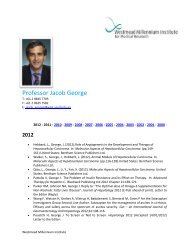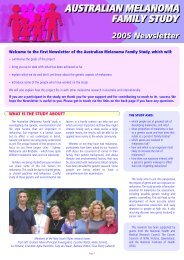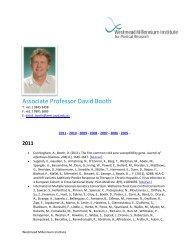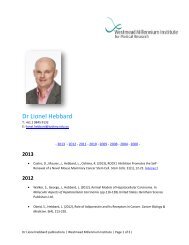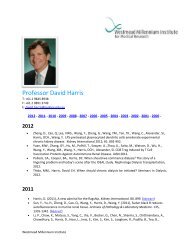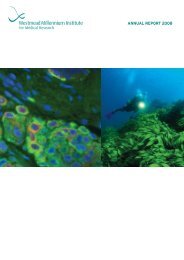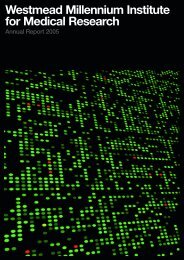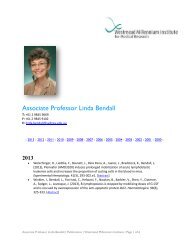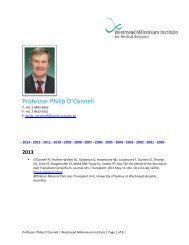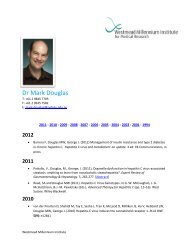Translating >> - Westmead Millennium Institute
Translating >> - Westmead Millennium Institute
Translating >> - Westmead Millennium Institute
- No tags were found...
Create successful ePaper yourself
Turn your PDF publications into a flip-book with our unique Google optimized e-Paper software.
34 35 > Research Report // AR 2006<br />
One aim of the group is to determine how HSV is assembled<br />
on to identify the first VZV encoded anti-apoptotic gene<br />
Oral bacteria and infective endocarditis<br />
porphyrin macrocycle and therefore must obtain this from<br />
within cells at the molecular level. Recent work has identified<br />
ORF63. To further our understanding of VZV with human<br />
Streptococcus gordonii is a primary coloniser of oral<br />
tissue sources, usually from haem-proteins that may also<br />
crucial molecular interactions required for viral assembly.<br />
nerve cells the group has developed a novel model of VZV<br />
microbial biofilms. This organism is considered to be<br />
supply iron. Research at the institute has identified the so-<br />
Such information on viral assembly will allow development<br />
infection of intact human explant ganglia. The group has<br />
beneficial in the oral environment but pathogenic when it<br />
called HA2 receptor as a porphyrin receptor important in the<br />
of inhibitors of this process which may be candidates for use<br />
shown for the first time that VZV can infect intact human<br />
colonises heart valves as this results in infective endocarditis.<br />
acquisition and surface storage of haem. In recent work this<br />
as antivirals for control of recurrent herpes simplex.<br />
ganglionic cells and this is a novel way of studying the<br />
There is considerable interest in attempting to engineer<br />
receptor mechanism was effectively used to selectively target<br />
The group also aims to examine the mechanism(s) involved in<br />
the entry, axonal transport, assembly and exit of HSV-1 from<br />
neurons. The group’s studies have shown how HSV can travel,<br />
assemble and exit from specialized sites along human nerves.<br />
Another aim of the group is to determine how HSV and<br />
HIV are transported within cells at the molecular level.<br />
Recent discoveries have shown how virus transport in cells<br />
is dependent on interactions between specific viral proteins<br />
and cellular “motor proteins” and how in the case of HSV<br />
the virus escapes from nerves to infect skin and cause disease.<br />
Such information on viral transport will allow development<br />
of inhibitors of this process which may be candidates for use<br />
as antivirals for control of recurrent herpes simplex or HIV.<br />
Varicella zoster virus<br />
Despite its significant impact on the community, little is<br />
known about the molecular basis of the Varicella zoster<br />
virus (VZV), due in part, to VZV only infecting humans.<br />
To more closely examine the interaction of VZV with host<br />
cells, the group has established several models of infection<br />
using human cell-types which are targets for infection and<br />
are relevant to those that suffer from either Varicella or herpes<br />
zoster/PHN because each of these cell types are likely to play<br />
different, but essential roles in the disease process. These<br />
include human fibroblasts (skin cells), neurons (nerve cells)<br />
and specialized immune cells (T cells and dendritic cells).<br />
The group has recently shown that human nerve cells<br />
infected with VZV do not undergo programmed cell death<br />
(apoptosis). This is an important finding because it suggests<br />
the nerve cell damage observed when VZV reawakens from<br />
its “silent” state in nerve cells to cause shingles is not due<br />
to programmed cell death. Another implication from this<br />
observation is that VZV encodes a function to interfere with<br />
the death response in human nerve cells, thus providing<br />
a possible mechanism by which the virus can establish<br />
and maintain its life-long dormant infection. We went<br />
interaction of this virus with human nerve cells.<br />
These features of intact ganglionic infection can now be<br />
studied in further detail to better define the molecular<br />
mechanisms that underlie VZV infection of ganglionic cells.<br />
For example, this model provides a means to rapidly test<br />
viral gene mutant viruses and new candidate vaccine strains<br />
containing targeted gene disruptions to define viral genes that<br />
may play critical roles in VZV neurotropism and to examine<br />
in detail the outcome of infection of both neurons and nonneuronal<br />
cells with respect to apoptosis and cell function.<br />
<strong>Institute</strong> of Dental Research<br />
Proteomics and structural genomics of oral pathogens<br />
The difficulty in preventing dental caries results from the<br />
need to devise a strategy to eliminate key cariogenic species<br />
without disrupting the overall complexity of the protective<br />
biofilm community on teeth. Solving this problem is at<br />
the forefront of research at the institute. The completion of<br />
a comprehensive series of comparative proteome studies,<br />
involving both planktonic and biofilm grown cells, has<br />
highlighted a number of biochemical events that are unique<br />
for the survival of the cariogenic pathogen, Streptococcus<br />
mutans, that proliferates under acidic conditions in dental<br />
plaque. Genes implicated in these adaptive responses,<br />
including alteration in acid tolerance and biofilm formation,<br />
are being systematically examined using a functional<br />
genomics approach. By defining the critical events associated<br />
with the survival and proliferation of S. mutans under<br />
conditions that lead to enamel dissolution, researchers at<br />
the <strong>Institute</strong> are gaining the necessary knowledge to develop<br />
a comprehensive strategy for intervention, thus allowing<br />
appropriate susceptible biochemical events to be targeted to<br />
control or eliminate disease.<br />
this bacterium to be both non-pathogenic and to resist<br />
displacement by oral pathogens such as Streptococcus<br />
mutans. In vitro gene expression technology has identified the<br />
gom locus comprising a regulon of 15 open reading frames<br />
implicated in bacterial growth, beneficial adhesion to the tooth<br />
surface, and pathogenic colonisation of heart valves. Analysis<br />
of this locus by researchers at the institute has focused on a<br />
group of novel glycosidases within the gom locus with the<br />
3D-structure of the first of these, GcnA, recently having being<br />
solved at high resolution. Current research is directed at the<br />
selective inhibition of this glycosidase as well as to determining<br />
the structure and function of other products of the gom locus<br />
including two related glycosidases that are also implicated in<br />
infective endocarditis.<br />
Polymicrobial aetiology of caries progression<br />
In studies at the institute, some eighty bacterial species<br />
were detected within the polymicrobial consortia of carious<br />
dentine that overlies the pulp following an extension of the<br />
enamel lesion of dental caries. However, recent studies have<br />
shown that pulpal infection, arising from end-stage disease, is<br />
far more selective. By using fluorescence in situ hybridisation<br />
(FISH), the complex consortia of bacteria associated with<br />
carious dentine has been shown to mass at the periphery of<br />
the soft tissue, with only a few species invading. Currently,<br />
the structural framework and spatial arrangement of bacterial<br />
invasion is being mapped. While clinically important from<br />
a dental perspective, this process also provides a rare insight<br />
into the dynamics of polymicrobial infections that impact<br />
severely on human health, particularly chronic infections.<br />
Targeted control of oral pathogens<br />
Competition for iron is considered to be a central event in<br />
many infections. A number of pathogenic bacteria have<br />
acquired complex mechanisms to sequester iron, often from<br />
haem. The periodontal pathogen, Porphyromonas gingivalis,<br />
is unusual in that it has lost the capacity to synthesise the<br />
and inhibit this bacterium with custom synthesised modified<br />
porphyrin-antibiotic conjugates. More recently, a number of<br />
other haem binding proteins that are located on the surface<br />
of the organism have been identified and are being studies<br />
in order to expand the range of targets for inhibition by<br />
exploiting those aspects of porphyrin storage and transport<br />
that are unique to P. gingivalis.<br />
Determinants of oral infection in high-risk<br />
aboriginal communities<br />
Anaerobic Gram negative bacteria have been determined<br />
to be numerically important in relation to the early onset<br />
and high incidence of periodontal disease in an Aboriginal<br />
community. Research at the institute has suggested that<br />
early mucosal colonisation of infants with pathogenic<br />
porphyromonads act as release sites for transmission of these<br />
organisms within families. Biotyping of Porphyromonas<br />
gingivalis strains based on variations in the lysine-gingipain<br />
gene indicated skewing of biotype distribution in the<br />
Aboriginal community compared with that observed in<br />
metropolitan cohorts. Further evidence for the presence<br />
of characteristic discriminatory flora within the Aboriginal<br />
community was obtained by microbial population analysis<br />
based on molecular phylogeny. These observations have<br />
provided a basis for ongoing dissection of the microbial risk<br />
factors for oral infection that prevail in such a high risk group<br />
and underpin proposed strategies to break the cycle of disease<br />
by preventing transmission to infants. Additionally, there is<br />
no information to determine whether disease susceptibility<br />
amongst Aborigines reflects organisms that have been<br />
associated with Aboriginal people for millennia or if there<br />
is a pathogenic influence from organisms acquired, most<br />
probably, from Anglo-Saxon settlers. As there is little genomic<br />
information for these mucosal pathogens, assessment of the<br />
origin and heterogeneity of organisms within communities<br />
is being assessed by analysis of a matrix of highly conserved<br />
house-keeping genes. This will both establish the relative



